How To Repair A Porch
Rescue an old wooden porch from the elements.
By Clint C. Thomas, Esq.
Your house is in a constant state of battle with the sunday and rain. The heat from the dominicus, peculiarly in the hot summertime months, wreaks havoc on paint and caulk. Rainwater presents the biggest long-term threat to whatever manmade structure. Wind and extreme cold temperatures also pose their own threats to houses. Even if a firm has an exterior veneer comprised of brick, stone or vinyl, other parts of the house will still exist constructed of woods. Porches are about always made of forest, and many older homes accept a porch floor made from tongue-and-groove lumber.
Knowing the devastating effects that water volition have on a woods porch, older homes were built and so the porch floors gently sloped from the business firm to the outside border of the porch. This was done to permit rainwater to run off the porch and not accumulate in puddles that would somewhen rot the flooring. In addition to a water-draining design, older homes likewise had the advantage of being painted with lead-based pigment. Now no longer used due to wellness and ecology concerns, lead-based paint, for all of its negatives, was very durable. Our grandparents would only have to paint their houses every twenty to thirty years. Whereas, our generation is having to repaint nearly every ten years with 15 years being on the exterior extreme.
The porch on one of my houses had taken a beating over the years and was start to show signs of serious water-related problems. A couple of the columns supporting the roof were beginning to sink into the floor, and one outside edge is what I refer to as a "trouble spot" because of where information technology is situated. A gable on the main roof of the business firm channels a lot of h2o onto the cease of the porch roof, which is synthetic with a 23.five-degree outside bending of its own. This results in a heavy amount of runoff beingness blown into this stop of the porch.
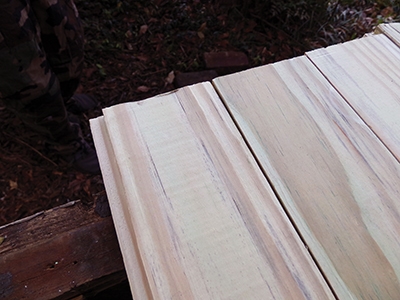
I decided to supervene upon the entire side of porch flooring with the exception of a roughly 4-ft. bridge that I could tell was the original porch flooring from when the business firm was built in 1880. Since this department was withal in pretty good shape and was also original to the house, I decided to leave information technology and only replace what was on both sides of it.
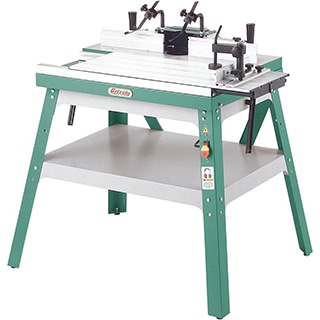
Materials
I am of the belief that the only ii materials to use on the exterior of historic homes are pressure-treated lumber or some type of plastic/polymer product. The two porch columns that were sinking into the floor were in skilful shape since someone else had already replaced their wooden bases with blended bases. Even though the flooring under the base plate was rotting, which caused the posts to sink, the bases themselves were in perfect shape.
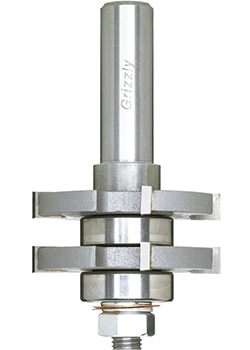
In social club to repair my porch I needed to use tongue-and-groove (T&Thousand) lumber. However, I've yet to find any place that sells force per unit area-treated T&G lumber. The flooring that I was replacing was untreated ane×4 T&Thou pine. I decided to factory my own T&G from pressure-treated 1x4x8 stock.
In lodge to practise this, I would purchase twenty to thirty pieces of treated 1x4x8 from my local lumber yard at a fourth dimension, making sure that I would go the best looking pieces (not warped or bowed). The next stride is to permit the lumber dry out. Treated lumber is milled while it is wet and is unremarkably still wet when it is received by the lumber yard. Through trial and error, I determined it is much harder to manufacturing plant a natural language and groove on moisture wood. However, don't just throw the wood into the August sun for a couples of days, because it will warp and bow in unimaginable ways. I learned this the hard manner. The best method is to stack the lumber tightly together in a bundle and place some weighted objects on height of it at each finish and in the centre. Lay the bundle of lumber in a place that gets some sun only not the full direct sun of belatedly summer. Afterwards about three days of this, move the lumber onto your porch out of the sunday. Rearrange the lumber in the bundle; place the wetter pieces toward the acme of the stack and exit it for the remainder of the week.
Milling
Once the woods has dried out sufficiently it tin hands be milled on a router table using a tongue-and-groove fleck. I adopt using a router bit with a two-in. arbor for this job. I also highly recommend purchasing a router with the highest horsepower you lot can find and one from a reputable manufacturer. Running twenty and thirty boards through a router, adjusting the bit for the other side, and so making the aforementioned number of passes puts a lot of strain on the router motor.
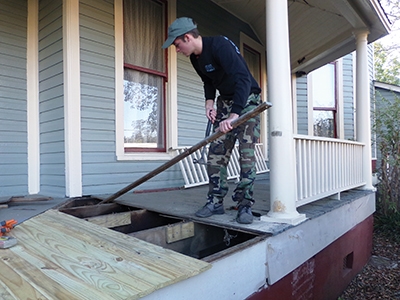
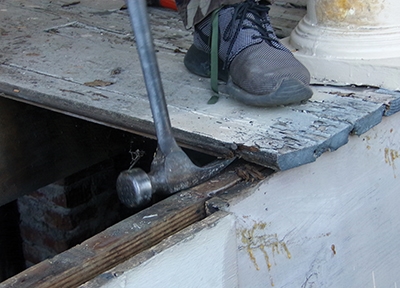
As I milled the tongue, or male end, on each piece I would run a ane/4-in. wood chisel downward either side of the tongue to clean up the cut and make certain it was smooth. In one case the wood is milled, be sure to stack information technology back every bit previously described out of direct sunlight, weighting the stack to prevent warping or bowing.
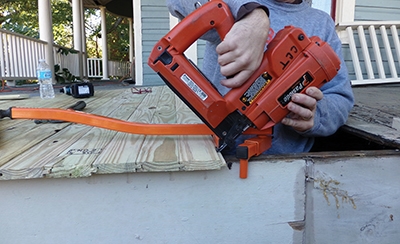

A BoWrench is a handy tool for bending bowed boards and for closing T&G joints.With the lumber milled, brainstorm removing the old porch flooring. My son Sterling and I used framing hammers and a pry bar to pull information technology all up without much difficulty.
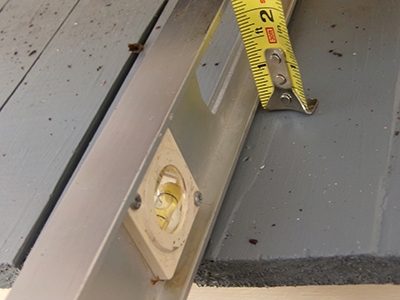
The hard part came when we reached a column. Needless to say, it's not feasible to simply remove the floor from nether the column. The column is supporting the roof, therefore the load has to be supported to remove the column. In order to practice this, we removed the flooring upward to the column and so placed a twenty-ton hydraulic canteen jack on meridian of the brick foundation nether the porch. We used a rough cut iv×iv mail as the jacking slice between the jack and the porch header. I and then slowly jacked that section of the porch upwards off the old flooring. Make certain that the 4×4 post you are using on top of the jack is perfectly plumb. I used a mail service-level for this chore. If the post is not plumb—straight upwardly and downwardly—the resulting angle can cause the post to skid, ofttimes violently, off the jack. This can result in bodily injury to whomever is operating the jack or impairment to your house when everything crashes back down, or both.
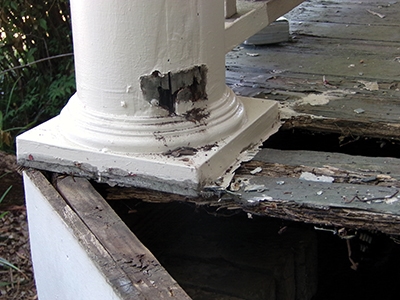
I also strongly recommend removing the old floor and installing new flooring upward to a point that is near to each column to be jacked-upward. Since the boards interlock each other, having the mating boards in identify reduces the amount of time that whatever one cavalcade will be suspended in mid-air past but the jack. Too, be sure to place the jack on the side of the column that is the farthest from the expanse that yous are working. Otherwise, you will run into the jack before you have installed the new floor under the column.
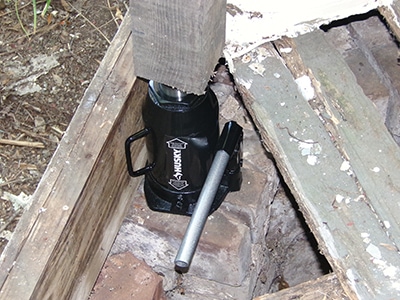
With the column suspended nosotros were able to remove the former flooring beneath it. We used a reciprocating saw with a metal-cut blade to remove a blast or ii that nosotros discovered nether the column.
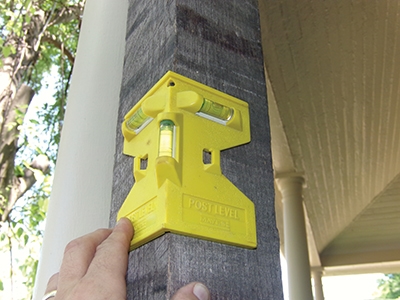
Installing the newly milled T&G flooring was probably the nearly hard office of the project. Some of the pieces would slide easily together while others were very stubborn and had to be persuaded together. Through experience my son and I adamant that the best way to install each piece was to first at the exterior and slide the new piece of flooring along the tongue of the last one installed. Fifty-fifty with using conscientious storing techniques there will be some minor warping and cupping that make the installation procedure more hard.
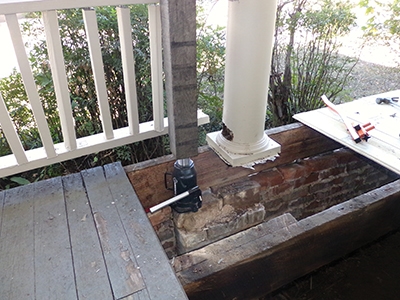
Every bit each slice is fitted in identify I would smash it diagonally (45-deg. angle) through the tongue. This eliminates whatsoever holes on the exterior of each piece of wood. We discovered that in the nailing process the outer edge of the new piece of floor would exist pushed down slightly past virtue of the downward pressure level exerted by the nail gun. This downwards bending of the board would hinder the installation of the side by side piece until we learned to rectify the trouble by hitting each installed lath from the bottom with a hammer directly next to each joist that information technology was nailed into. This eliminated a lot of installation problems.
For the most part, any piece of floor that wouldn't easily slide the entire length of the concluding installed piece could and then be persuaded by a few firm blows from a hammer and block on its exterior cease.
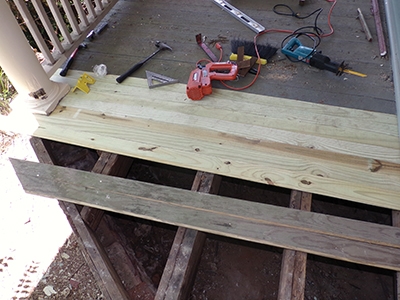
In gild to obtain a tight jointing of each piece of T&M lumber we employed a tool called a BoWrench. This is a truly wonderful device that clamps itself onto a floor joist and so uses the reverse pressure to place tension on the piece of lumber being installed. It comes with a regular head that fits around modern ii× type lumber. Withal, I recommend the adjustable head that will permit it to fit over true dimensional lumber and also over multiple pieces of mod 2× type lumber.
All of the bending cuts were made using a miter saw. Once installed, the outside ends of the new pieces of porch floor were cutting off with a jig saw after marking a directly line with a chalk-reel.
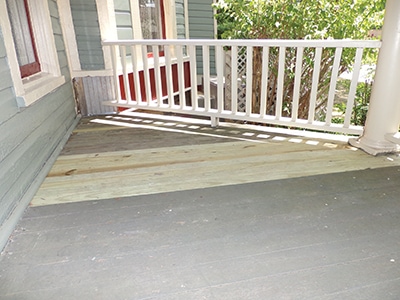
Every bit a final proposition, the jacking up of the columns also necessitated the removal of the porch railings. The best and easiest way to exercise this is to loosen the joints where they connect to each cavalcade then run a reciprocating saw with a metal-cutting blade through the joint to cutting the nails off. Once each section of railing is loosened information technology can then be removed by lifting it up and sliding information technology out of place. Porch columns, especially older ones, are tapered then they are wider at the bottom and more narrow at the peak. This allows for the easy removal of the railings.
My side porch measures 22-ane/2-by-7 feet. I replaced all but about 4 feet of the entire side of my porch with pressure-treated T&G lumber that I milled myself for a price of less than $300.00. Comparison that to what a contractor would charge for the same work, it makes me glad I know how to practise it myself.
Source: https://extremehowto.com/repair-for-an-old-wooden-porch/

0 Response to "How To Repair A Porch"
Post a Comment